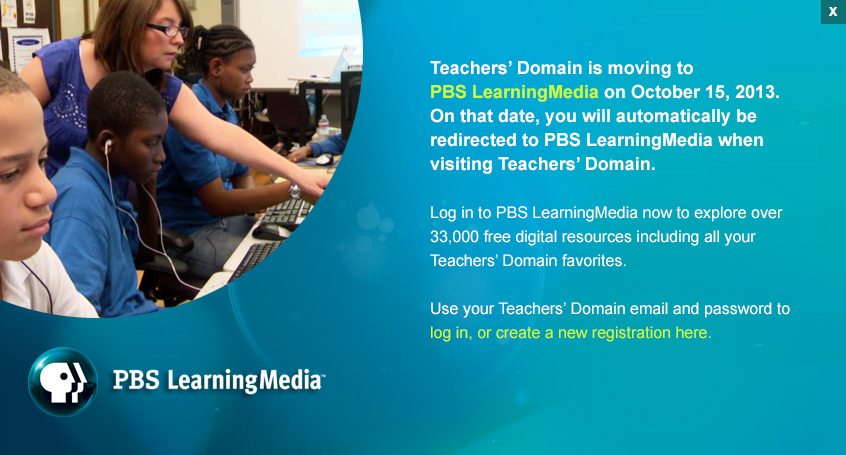Teachers' Domain - Digital Media for the Classroom and Professional Development
User: Preview
Chromosome Viewer
(Interactive)
Double Immunity
(Video)
How Cells Divide: Mitosis vs. Meiosis
(Interactive)
How Genetic Disorders Are Inherited
(Document)
A Mutation Story
(Video)
One Wrong Letter
(Video)
 Loading Standards
Loading StandardsIn this activity, students learn how mutations in a gene can cause disease. They simulate the inheritance patterns of several different diseases caused by recessive genes. They learn how some recessive genes confer an advantage in the heterozygous state in certain environments. Finally, they identify and research five genetic disorders they would like to know more about and present their findings to the class.
When Talking About Genetics
Some students may have genetic diseases in their family or know
someone with a genetic disease. Try to be sensitive to students'
feelings by discussing the diseases in terms of genetic mutations,
or variations, rather than using terms like "defective"
or "inadequate" genes. Let students know that everyone has
mutations in their genetic makeup; not all of these are harmful.
Some genetic variations are neutral and others are beneficial.
1. Give each student two index cards, one of each color. Tell them that these cards represent genes for an unknown trait. Assign an allele to each card (for example, the blue card is "A" and the white card is "a"), and have students write the appropriate symbols on their cards. Ask:
Explain that each student is heterozygous for this trait because he or she has one dominant and one recessive gene.
2. Ask students to pair up. Have the students in each pair hold their gene cards behind their back, shuffle them, count to three, and then put one card in front of them. Tell them to pretend that each card is a gamete, and together the two cards shown represent a possible genotype of the first offspring of parents with these alleles. Ask students to write down the genotype of this offspring. Then have students repeat this process until they have determined and written down the possible genotypes for a total of four offspring in this family.
3. Show the One Wrong Letter video about Tay-Sachs disease. Ask:
4. Ask students:
Show the video A Mutation Story and ask:
5. Have students look at the Genetic Drift and the Founder Effect image and read the background essay. Ask:
6. Point out that Tay-Sachs disease, sickle cell anemia, and Ellis-van Creveld syndrome are three examples of genetic disorders caused by recessive genes. Some genetic disorders, such as Huntington disease, are caused by a dominant gene. Huntington disease is not usually expressed until the person is between thirty and forty years of age. It causes degeneration of the nerves, dementia, and eventually death. Ask:
Show the How Genetic Disorders Are Inherited transparency or give it to students as a handout. Ask:
7. Also emphasize that some genetic disorders, like Tay-Sachs disease and sickle cell anemia, are determined by a single gene. These are known as Mendelian disorders. Other diseases, such as breast cancer and diabetes, can be influenced by the interaction of several genes as well as by factors in the environment. They are known as multifactorial diseases.
8. Show the video Double Immunity and discuss the following:
9. Have students look at the Chromosome Viewer Web activity to identify the specific chromosomes on which the four disorders mentioned above (Tay-Sachs, sickle cell anemia, Ellis-van Creveld, and Huntington's) are located. Then have each student review the twenty-three chromosomes and identify five diseases that they would like to know more about. Make a class list, then choose the top five genetic disorders students would like to research. Point out that some genetic disorders are caused not by mutations but by extra or missing chromosomes. Nondisjunction is the failure of chromosome pairs to separate during meiosis I anaphase, and it can cause some eggs/sperm to gain an extra chromosome and others to lose one. For example, Down's syndrome is caused by an extra copy of chromosome 21. (To illustrate nondisjunction, see the How Cells Divide: Mitosis vs. Meiosis Web activity.)
10. Using the student-generated list of five genetic disorders to research, have the class brainstorm questions they want to answer about these diseases. If the following topics are not suggested, add them to the list: genetic cause, location on chromosomes (or which chromosomes have an extra copy or are missing), Mendelian or multifactorial, rate of occurrence in different populations, treatment, etc.
11. Divide the class into five teams. Have each team research a different disease and prepare a presentation using library and multimedia Web resources (see Cracking the Code of Life, http://www.pbs.org/wgbh/nova/genome/resources.html, to get started). Then have each team present information about their disease to the class.
12. Summarize by asking teams to identify the similarities and differences in inheritance patterns of the five different diseases.
 Teachers' Domain is proud to be a Pathways portal to the National Science Digital Library.
Teachers' Domain is proud to be a Pathways portal to the National Science Digital Library.
